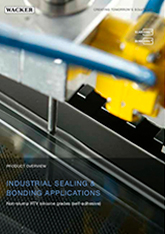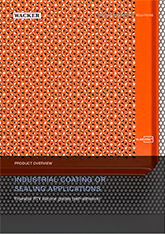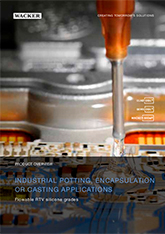Our system has noticed that you are based in United States, but the current country setting is Vietnam. Do you still want to change your country?
Paper & Packaging

VINNAPAS® polymer dispersions are used to formulate a broad range of paper and packaging adhesives. They are notable for their strong adhesion to a large number of substrates, very high heat resistance, excellent machinability and versatile formulation properties.
WACKER’s Technical Centers are equipped to test different formulations of paper and packaging adhesives. Here: Testing of setting speed.
Produktempfehlungen
|
Produkte
|
Technische Daten
|
Produktmerkmale
|
Paper & Packaging
|
||||||||||
|---|---|---|---|---|---|---|---|---|---|---|---|---|---|
| Mindesttemperatur Filmbildung | Feststoffanteil | dynamische Viskosität | Glasübergangstemperatur | Nachhaltigkeitsthemen |
Haftung
|
Reinigungsfähigkeit
|
Düsenauftrag
|
Cohesion/ heat resistance
|
Walzen-/Rollenauftrag
|
Abbindeverhalten
|
Wasserdichtigkeit
|
||
| - - | - - | - - | - - | - | - | - | - | - | - | - | - | ||
| 0 °C[1] 32.0 °F[1] | - - | - - | - - | - | - | - | - | - | - | - | - | ||
| - - | - - | 1800 - 2700 mPa·s 1800 - 2700 mPa·s | approx. 14 °C[2] approx. 57.2 °F[2] | - | Hoch | Hoch | Mittel | Hoch | Hervorragend | Hoch | Mittel | ||
| - - | 54.0 - 56.0 % 54.0 - 56.0 % | 800 - 2000 mPa·s 800 - 2000 mPa·s | approx. -20 °C[3] approx. -4.0 °F[3] | - | Hervorragend | Mittel | Mittel | Mittel | Mittel | Hoch | Hoch | ||
| - - | 44 - 48 % 44 - 48 % | 6000 - 14000 mPa·s 6000 - 14000 mPa·s | approx. 30 °C[2] approx. 86.0 °F[2] | - | Mittel | Hoch | Mittel | Hervorragend | Mittel | Hoch | Hoch | ||
| - - | 58 - 61 % 58 - 61 % | 4500 - 9500 mPa·s 4500 - 9500 mPa·s | approx. -35.0 °C[3] approx. -31 °F[3] | - | Hervorragend | Mittel | Mittel | Mittel | Mittel | Mittel | Mittel | ||
| - - | 54 - 56 % 54 - 56 % | 100 - 500 mPa·s 100 - 500 mPa·s | approx. -15 °C[2] approx. 5.0 °F[2] | - | - | - | - | - | - | - | - | ||
| - - | 62.0 - 64.0 % 62.0 - 64.0 % | 600 - 1500 mPa·s 600 - 1500 mPa·s | approx. 0 °C[3] approx. 32.0 °F[3] | - | Hervorragend | Hoch | Mittel | Mittel | Hoch | Hoch | Mittel | ||
| - - | 49.0 - 51.0 % 49.0 - 51.0 % | 4000 - 6000 mPa·s 4000 - 6000 mPa·s | approx. 3 °C[2] approx. 37.4 °F[2] | - | Hoch | Hervorragend | Mittel | Hoch | Hoch | Hoch | Hoch | ||
| - - | 54.0 - 56.0 % 54.0 - 56.0 % | 3500 - 5500 mPa·s 3500 - 5500 mPa·s | approx. 2 °C[2] approx. 35.6 °F[2] | - | Hoch | Hervorragend | Hervorragend | Hoch | Hervorragend | Hoch | Mittel | ||
| - - | 54 - 56 % 54 - 56 % | 4000 - 9000 mPa·s 4000 - 9000 mPa·s | approx. 5 °C[2] approx. 41.0 °F[2] | - | Hoch | Hoch | Mittel | Hoch | Hoch | Hoch | Hoch | ||
| - - | 69.5 - 71.5 % 69.5 - 71.5 % | 1200 - 2700 mPa·s 1200 - 2700 mPa·s | approx. -3 °C[3] approx. 26.6 °F[3] | niedriger Formaldehydgehalt, ohne APEO hergestellt | Hoch | Hoch | Mittel | Hoch | Hoch | Hervorragend | Hervorragend | ||
| - - | 54.0 - 56.0 % 54.0 - 56.0 % | 2000 - 4000 mPa·s 2000 - 4000 mPa·s | approx. -10 °C[2] approx. 14.0 °F[2] | - | Hervorragend | Mittel | Mittel | Mittel | Hoch | Hoch | Hoch | ||
| - - | 54 - 56 % 54 - 56 % | 1900 - 2800 mPa·s 1900 - 2800 mPa·s | approx. 0 °C[2] approx. 32.0 °F[2] | - | Hoch | Hoch | Mittel | Hoch | Hervorragend | Hoch | Hoch | ||
| - - | 54 - 56 % 54 - 56 % | 2900 - 3900 mPa·s 2900 - 3900 mPa·s | approx. 0 °C[2] approx. 32.0 °F[2] | - | Hoch | Hoch | Hoch | Hoch | Hervorragend | Hoch | Hoch | ||
| - - | 54 - 56 % 54 - 56 % | 3500 - 4500 mPa·s 3500 - 4500 mPa·s | approx. 0 °C[2] approx. 32.0 °F[2] | - | Hoch | Hoch | Hoch | Hoch | Hervorragend | Hoch | Hoch | ||
| - - | 54 - 56 % 54 - 56 % | 4400 - 5400 mPa·s 4400 - 5400 mPa·s | approx. 0 °C[2] approx. 32.0 °F[2] | - | Hoch | Hoch | Hoch | Hoch | Hervorragend | Hoch | Hoch | ||
| - - | 54 - 56 % 54 - 56 % | 1300 - 2000 mPa·s 1300 - 2000 mPa·s | approx. 0 °C[2] approx. 32.0 °F[2] | - | Hoch | Hoch | Mittel | Hoch | Hoch | Hoch | Hervorragend | ||
| - - | 54 - 56 % 54 - 56 % | 2700 - 3700 mPa·s 2700 - 3700 mPa·s | approx. 7 °C[2] approx. 44.6 °F[2] | - | Hoch | Hoch | Mittel | Hoch | Hervorragend | Hoch | Hoch | ||
| - - | 54 - 56 % 54 - 56 % | 1500 - 2500 mPa·s 1500 - 2500 mPa·s | approx. 19 °C[2] approx. 66.2 °F[2] | - | Hoch | Hoch | Mittel | Hervorragend | Hervorragend | Hoch | Mittel | ||
| - - | 54 - 56 % 54 - 56 % | 4000 - 9000 mPa·s 4000 - 9000 mPa·s | approx. 5 °C[2] approx. 41.0 °F[2] | - | - | - | - | - | - | - | - | ||
| - - | 59.5 - 61.5 % 59.5 - 61.5 % | 2000 - 3000 mPa·s 2000 - 3000 mPa·s | approx. 0 °C[2] approx. 32.0 °F[2] | - | Hoch | Hoch | Mittel | Hoch | Hervorragend | Hoch | Hoch | ||
| - - | 59.5 - 61.5 % 59.5 - 61.5 % | 2000 - 3000 mPa·s 2000 - 3000 mPa·s | approx. 0 °C[2] approx. 32.0 °F[2] | - | - | - | - | - | - | - | - | ||
[1] Mindesttemperatur Filmbildung | DIN ISO 2115, [2] Glasübergangstemperatur | spezifische Methode, [3] Glasübergangstemperatur | DSC, spezifische Methode, [] Geeignet, [] Gut geeignet, [] Ideal geeignet














